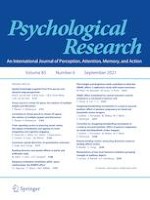31-08-2020 | Original Article
SNARC effect modulated by central executive control: revealed in a cue-based trisection task
Gepubliceerd in: Psychological Research | Uitgave 6/2021
Log in om toegang te krijgenAbstract
People respond to small numbers faster with the left hand and respond to large numbers faster with the right hand, a phenomenon known as the Spatial-Numerical Association of Response Codes (SNARC) effect. Whether the SNARC effect originates from culturally determined long-term experience or the task-set-influenced temporary associations among spaces, locations, and numerical magnitudes in working memory (WM) is still controversial. In the present study, we used a trisection paradigm in which numbers were divided into three categories (small: 1, 2; middle: 4, 5, 6; and large: 8, 9) to explore whether the central executive control can modulate the SNARC effect. Participants were serially presented with a cue and a target number. The cue denoted a task rule, which informed participants to compare the target number with either 3 or 7. The cue was either switched or repeated across trials. We found that the SNARC effects were observed in the cue-switching condition. In the cue-repeat condition, the SNARC effect disappeared. These findings suggest that the SNARC effect is modulated by set-shifting-related central executive control in WM, supporting the view that the SNARC effect is WM-dependent.
